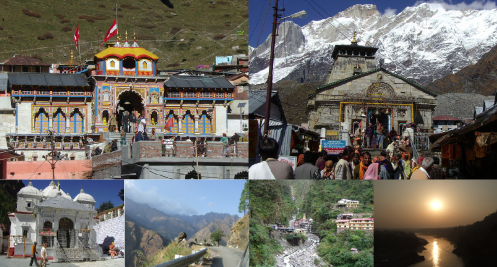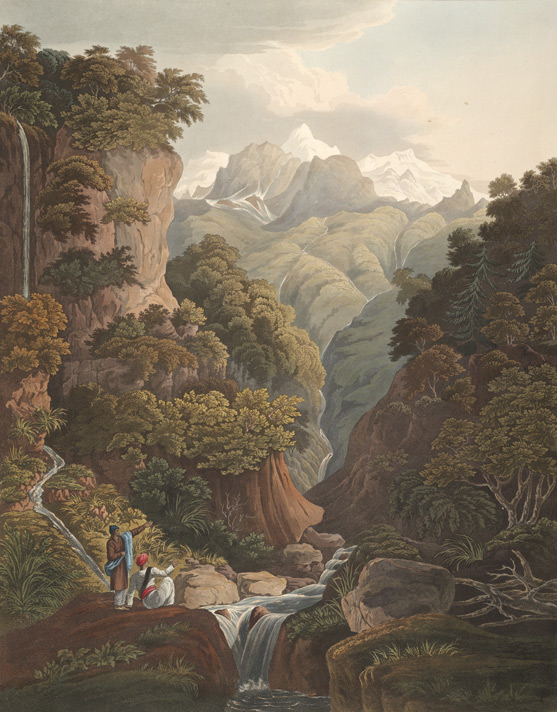Chardham Yatra is the most popular spiritual yatra starting from April-May and continues till Oct-Nov every year in Uttarakhand India.
Even though 9 days can be sufficient for a tour to the four sites of India’s Char Dham pilgrimage – Yamunotri (3293m), Gangotri (3415 m), Kedarnath (3553 m) and Badrinath (3753 m) – we offer yatra packages from 3 days to 12 days, tailored to your needs. Choose your preferred time frame, vehicle and accommodation. English or Hindi speaking tour guides available.
Experience the divinity and mysticism of these sacred shrines as we take you on a journey through the Garwhal region of Uttarakhand, the state in North India, also called ‘Dev Bhumi’, the Abode of Gods! With its picturesque surroundings, mountain climate (Himalayas), dense forests, large valleys and enthralling environment, the region allows you to unwind yet experience the majestic locations of this popular pilgrimage route.
Located only a few kilometers from the Indo-China (Tibet) border, Badrinath was re-established as a major pilgrimage site by Adi Shankara in the ninth century, but it as been mentioned as a holy place in scriptures and legends for thousands of years.
According to the Hindu scriptures, the holy centres of Gangotri, Yamunotri, Badrinath and Kedarnath – collectively called the Char Dham (meaning the four sacred spots) – are the most sacred of all the pilgrimages – with Badrinath being the most important of the four sites. It is also said that heaven and earth converge in these holy spots, and to be born or die here is a boon only the very fortunate have.
The Chardham should be visited from left to right – beginning with Yamunotri, followed by Gangotri, Kedarnath and Badrinath. This route follows the Hindu tradition of parikrama or clockwise circumambulation.
The Char Dhams are open for the general public from first week of May till October depending upon the weather conditions in the region.
For bookings - Please call Mr. Sohan Kumar on +91-9557417765 Book Now




Background information: Char Dham is referred to the four most holy Hindu pilgrimage of India nestled in Indian Himalayas of Uttarakhand state of India. Yamunotri, Gangotri, Sri Kedarnathji and Sri Badrinathji, collectively referred to as the Char Dham (four pilgrimage centres). Traditionally, the Chardham yatra is undertaken from the west to the east follows the Hindu tradition of parikrama, thus the yatra starts from Yamunotri, then proceeding to Gangotri, then Kedarnath and culminating the journey at Badrinath. Devotees also visit Gurudwara Sri Hemkund Sahib Ji the pilgrimage site for the Sikhs, and is one of the highest located religious sites in the country.
Shri Badrinath Dham: is considered the holiest of the four important shrines. The town is at an altitude of 3,133 m. above sea level, situated on the left bank of river Alaknanda and exactly between the two mountains Nara and Narayan and the shadow of Nilkantha peak. The shrine is dedicated to Vishnu the preserver and protector of the Hindu Divine Trinity.
Shri Kedarnath Dham: The Kedarnath shrine, one of the 12 jyotirlingas of Lord Shiva, Kedar is another name of Lord Shiva, the protector and the destroyer. According to legend, the Pandavas after having won over the Kaurava in the Kurukshetra war, felt guilty of having killed their own brothers and sought the blessings of Lord Shiva for redemption. He eluded them repeatedly and while fleeing took refuge at Kedarnath in the form of a bull. On being followed he dived into the ground, leaving his hump on the surface. The remaining portions of Lord Shiva appeared at four other places and are worshipped there as his manifestations. The arms appeared at Tungnath, the face at Rudranath, the belly at Madhmaheshwar and his locks (hair) with head at Kalpeshwar. Kedarnath and the four above-mentioned shrines are treated as Panch Kedar. It is where Lord Shiva manifested himself in the form of light, it is the third of the four dhams.
Gangotri Dham: The Shrine of Gangotri situated at an elevation of 3200 m above sea level amidst captivating surroundings along the right bank of Bhagirathi is 100 km from Uttarkashi. The temples opening is preceded by a special Puja of Ganga both inside the temple as well as on the river bank. Gangotri,the source of the Ganges river and seat of Goddess Ganga;
Yamunotri Dham: is the Source of Yamunotri River and the seat of Godess Yamuna,it is the westernmost shrine in the Garhwal Himalayas,The main attraction at Yamunotri is the temple devoted to the Goddess Yamuna and the holy thermal springs at Janki Chatti. The temple of Yamuna, on the left bank of the Yamuna, was constructed by Maharaja Pratap Shah of Tehri Garhwal. The deity is made of black marble. The Yamuna, like the Ganges, has been elavated to the status of a divine mother for the Hindus and has been held responsible for nurturing and developing the Indian civilization.
The Garhwal Himalayas: are mountain ranges located in the state of Uttarakhand and covers the districts of Chamoli, Pauri Garhwal and Rudraprayag. Magnificient nature, dense forests and lush terraced valleys, breathtaking mountain peaks and glaciers. Garhwal has more than 20 summits over 6000 m, the highest are Nanda Devi (7817m) and Kamet (7756m), rich flora and fauna plus a range of beautiful temples, which are off the mainstream paths, almost hidden gems. Uttarakhand is also revered as the ‘Land of the gods’ (Dev Bhoomi) and every mountain, place, rock and stream of Uttarakhand is somewhat associated with the mythological background of India. Garhwalis relate every peak, lake or mountain range to a God or Goddess, mythological personality, event or saint. Gangotri is for example connected with the legend of Ganga descending from heaven. And Agastyamuni, Srinagar, Parkandi (Khat Sali, Jaunsar), Dewalgarh and Rudraprayag are considered to be sacred because sages like Agastya, Kapil, Parashar, Dattatreya and Vishwamitra had done penance there. (Source: The Holy Himalaya: A Geographical Interpretation of Garhwal by Nitya Nand, Kamlesh Kumar).
Haridwar: is an important pilgrimage city, companioned by river Ganges. The river Ganges after flowing for 253 kilometres from its source at Gaumukh, enters the Indo-Gangetic Plains of North India for the first time at Haridwar, which gave the city its ancient name, Gangadwára. Haridwar is viewed as one of the seven holiest places to Hindus. Amidst the Kumbha Mela, millions of pilgrims, devotees, and tourists congregate in Haridwar to perform ritualistic bathing on the banks of the river Ganges to wash away their sins. Brahma Kund is located at Har ki Pauri and is considered to be the most sacred ghat of Haridwar.
Rishikesh: is located in the foothills of the Himalayas and is known as ‘The Gateway to the Himalayas’. Rishikesh is located about 25 km north of holy city, Haridwar. Legends state that Lord Rama did penance here for killing Ravana, and Lakshmana, his younger brother, crossed the river Ganges, at a point, where the present ‘Lakshman Jhula’ bridge stands today. The sacred river Ganges flows through Rishikesh and leaves the Shivalik Mountains in the Himalayas, flowing out into the plains of northern India. Several temples, ancient with new are found along the banks of the Ganges in Rishikesh.